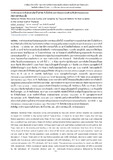การสำรวจและการเก็บตัวอย่างสัตว์น้ำหน้าดิน ในพื้นที่บริเวณอ่าวไทยตอนกลางด้วยเครื่องมือประมงลอบและเบ็ดราวหน้าดินแนวตั้ง (Demersal Fishery Resources Survey and Sampling by Trap and Bottom Vertical Longline in the Central Gulf of Thailand)
Abstract
การทำประมงด้วยเครื่องมือลอบและเบ็ดราวหน้าดินแนวตั้งครั้งนี้ ประสงค์ที่จะสำรวจและเก็บตัวอย่างสัตว์น้ำเพื่อใช้ในการศึกษาวิจัยด้านอื่น ๆ ที่เกี่ยวข้อง ในเที่ยวเรือสำรวจทรัพยากรประมงและสิ่งแวดล้อมทางทะเลในบริเวณอ่าวไทยตอนกลาง ระหว่างวันที่ 14 มีนาคม – 12 เมษายน พ.ศ. 2556 มีสถานีสำรวจประมงทั้งสิ้น 24 สถานี โดยใช้เครื่องมือลอบ 24 สถานี และเบ็ดราวหน้าดินแนวตั้ง 23 สถานี ซึ่งทำการประมงในบริเวณใกล้เคียงกัน การทำประมงลอบใช้ลอบ 3 แบบคือ ลอบปูพับได้, ลอบแบบวงรีพับได้และลอบทรงกระบอก ซึ่งจะใช้แบบละ 15 ใบต่อการทำประมง รวม 45 ใบต่อสถานี เหยื่อที่ใช้เป็นปลาทูแขกและปลาลัง ทำการประมงเวลาตอนเย็นและทิ้งไว้ 12 – 14 ชั่วโมงก่อนทำการกู้ลอบในเวลาตอนเช้าของอีกวัน และการทำประมงเบ็ดราวหน้าดินแนวตั้ง (เบ็ดกล่อง) โดยแต่ละครั้งจะปล่อยเบ็ดจำนวน 30 กล่อง รวมจำนวนเบ็ด 540 ตัวต่อสถานี ใช้หมึกเป็นเหยื่อ ทำการปล่อยเบ็ดในเวลาเช้ามืด ใช้เวลาในการปล่อยประมาณ 30 นาที ทิ้งไว้ 2 – 3 ชั่วโมง ก่อนทำการกู้เบ็ดในตอนเช้า ผลการจับสัตว์น้ำด้วยลอบทั้งหมด 46.35 กิโลกรัม มีจำนวนสัตว์น้ำ 1,008 ตัวอย่าง โดยแบ่งเป็นกลุ่มสัตว์น้ำเศรษฐกิจ 31.7 กิโลกรัม (235 ตัวอย่าง) และกลุ่มสัตว์น้ำที่ไม่ใช้สัตว์น้ำเศรษฐกิจ 14.65 กิโลกรัม (773 ตัวอย่าง) คิดเป็นร้อยละโดยน้ำหนัก 68.39 และ 31.61 ตามลำดับ โดยในกลุ่มสัตว์น้ำเศรษฐกิจ ชนิดของสัตว์น้ำที่จับได้มากสุดคือกลุ่มปูและที่จับได้มากคือ ปูลาย (Charybdis feriatus) และปูม้า (Portunus pelagicus) จำนวน 84 ตัว และ 15 ตัว ตามลำดับ คิดเป็นร้อยละ 42.31 ของกลุ่มสัตว์น้ำเศรษฐกิจ รองลงมาเป็น กลุ่มปลาทรายแดง (Nemipterus spp.) และปลาทรายขาว (Scolopsis sp.) ในวงศ์ Nemipteridae รวมจำนวน 57 ตัว ร้อยละ 24.26 และกลุ่มปลาเก๋า (Ephinephelus spp.) จำนวน 33 ตัว คิดเป็นร้อยละ 14.04 จากการสำรวจครั้งนี้ ได้ทดลองเปรียบเทียบประสิทธิภาพการจับสัตว์น้ำ กลุ่มปูของลอบแต่ละแบบเนื่องจากจับได้จำนวนมากที่สุด โดยการทดสอบค่าความแปรปรวนทางเดียวพบว่าไม่มีความแตกต่างระหว่างลอบทั้ง 3 แบบ (p-value = 0.0626) และผลการจับสัตว์น้ำด้วยเบ็ดราวหน้าดินแนวตั้ง จับได้จำนวน ทั้งสิ้น 233 ตัวอย่าง น้ำหนักรวม 106.6 กิโลกรัม คิดเป็นอัตราการลงแรง 18.8 ตัวต่อเบ็ด 1,000 ตัว โดยแยกเป็นกลุ่มสัตว์น้ำ เศรษฐกิจจำนวน 112 ตัวและไม่ใช่สัตว์น้ำเศรษฐกิจ 121 ตัว คิดเป็นร้อยละ 48.07 และ 51.93 ตามลำดับ ชนิดสัตว์น้ำที่จับได้ มากที่สุดเป็นกลุ่มปลาไหล (Eel) จำนวน 50 ตัวคิดเป็นร้อยละ 21.46 ของสัตว์น้ำทั้งหมด ตามด้วยเหาฉลาม (Echeneis naucrates) 33 ตัว และกลุ่มปลาทรายวงศ์ Nemipteridae 28 ตัว ซึ่งคิดเป็นร้อยละ 14.16 และ 12.07 ตามลำดับ และในการศึกษาครั้งนี้ได้ พิจารณาผลจับปลายอดจากด้วยเนื่องจากในปัจจุบันมีการรุกล้ำเข้ามาทำประมงปลาหมึกและปลายอดจากของเรือประมงจากประเทศเพื่อนบ้าน พบว่าจับได้ 2 สกุล (Muraenesox cinereus) และ (Congresox spp.) จำนวนรวม 27 ตัว ซึ่งจับได้มากบริเวณ กลางอ่าวไทยตอนล่าง
Demersal fishery resources survey and sampling by trap and bottom vertical longline was conducted on board M.V. SEAFDEC in the Central Gulf of Thailand from 14 March to 12 April 2013. Twenty-four (24) trap fishing operations were conducted using three (3) trap types: rectangular collapsible crab trap; oval collapsible trap; cylindrical trap, and twenty three (23) bottom vertical longline fishing operations were conducted. Forty-five (45) traps were deployed at each station (15 traps each type) and used Indian mackerel and round scads as bait. Traps were set in the evening and hauling at the next day morning with immersion time from 12 to 14 hours. Thirty boxes of bottom vertical longline with a total of 540 hooks were deployed at each operation. Squid was cut and used as bait. Fishing operations were conducted in early morning with approximate immersion time between 2 - 3 hours. Total catch of 24 trap fishing operation are 1,008 individuals, 46.4 kg in weight. Catch were classify into two groups; catch (commercial species) with 235 individuals, 31.7 kg in weight and by-catch (noncommercial species) with 773 individuals, 14.7 kg in weight. The percentage compositions by weight are 68% and 32%, respectively. Within commercial species group, crabs showed the highest composition of 42% is consisting by 84 individuals of Charybdis feriatus and 15 individuals Portunus pelagicus, followed by the family Nemipteridae, there were Scolopsis sp. and Nemipterus sp. were catch 57 individuals and 24% of commercial species. Ephinephelus sp. are the third composition of 14%, were 33 individuals. Regarding to commercial species, group of crabs were use to study on the efficiency comparison between type of trap by One-way analysis of variance method. There was no difference between the 3 types of trap (p-value = 0.0626). A total of 233 by number weighing approximately 106.6 kg were caught by Bottom vertical long line. The overall Catch Per Unit Effort (CPUE) was 18.8 individuals/1,000 hooks. Considering the catch composition by groups were found 112 individuals and 121 individuals, were 48%, 52% respectively. Eel showed the highest composition of 22%, 50 individuals followed by Echeneis naucrates and Nemipteridae, the composition were 14% and 12% with 33 and 28 individuals respectively. According to the fishing boat from neighboring countries were encroachments for squids and pike congers fishing in Thai EEZ, considering the catch results of pike conger Muraenesox cinereus and Congresox spp. were caught 27 by number and fishing ground was in the south of Central Gulf of Thailand
Citation
พรหมจินดา, ส., ชามะสนธิ์, อ., & มั่นประสิทธิ์, อ. (2013). การสำรวจและการเก็บตัวอย่างสัตว์น้ำหน้าดิน ในพื้นที่บริเวณอ่าวไทยตอนกลางด้วยเครื่องมือประมงลอบและเบ็ดราวหน้าดินแนวตั้ง. การสัมมนาวิชาการเรื่อง ผลการสำรวจทรัพยากรประมงและสิ่งแวดล้อมทางทะเลในบริเวณอ่าวไทยตอนกลางโดยเรือสำรวจซีฟเดค ปี 2556 (pp. 221-225). สมุทรปราการ: สำนักงานฝ่ายฝึกอบรม ศูนย์พัฒนาการประมงแห่งเอเชียตะวันออกเฉียงใต้.
Subject
Related items
Showing items related by title, author, creator and subject.
-
Efficiency Comparison of Circle Hook versus J-Hook in Pelagic Longline Fishery, Andaman Sea
Putsa, Santiphong; Promjinda, Sayan (Training Department, Southeast Asian Fisheries Development Center, 2016)The FAO Guidelines specified that longline fishery must develop and implement combinations of hook design, type of bait, depth, gear specification, and fishing practices that minimize sea turtle bycatch, incidental catch, ... -
SEAFDEC Seminar 2018: Fisheries and Marine Environment
Southeast Asian Fisheries Development Center, Training Department (Training Department, Southeast Asian Fisheries Development Center, 2018)Proceeding of SEAFDEC Seminar 2018: Fisheries and Marine Environment -
Study on Tuna Longline Fishery in Phuket Province
Buranawanich, Rattanakorn; Dusitkul, Kanyanut; Kayachat, Natchaya; Kapan, Masamon; Buanoi, Sawitchaya; Boutson, Anukorn (Training Department, Southeast Asian Fisheries Development Center, 2018)This is abstract on study on tuna longline fishery in Phuket province.




